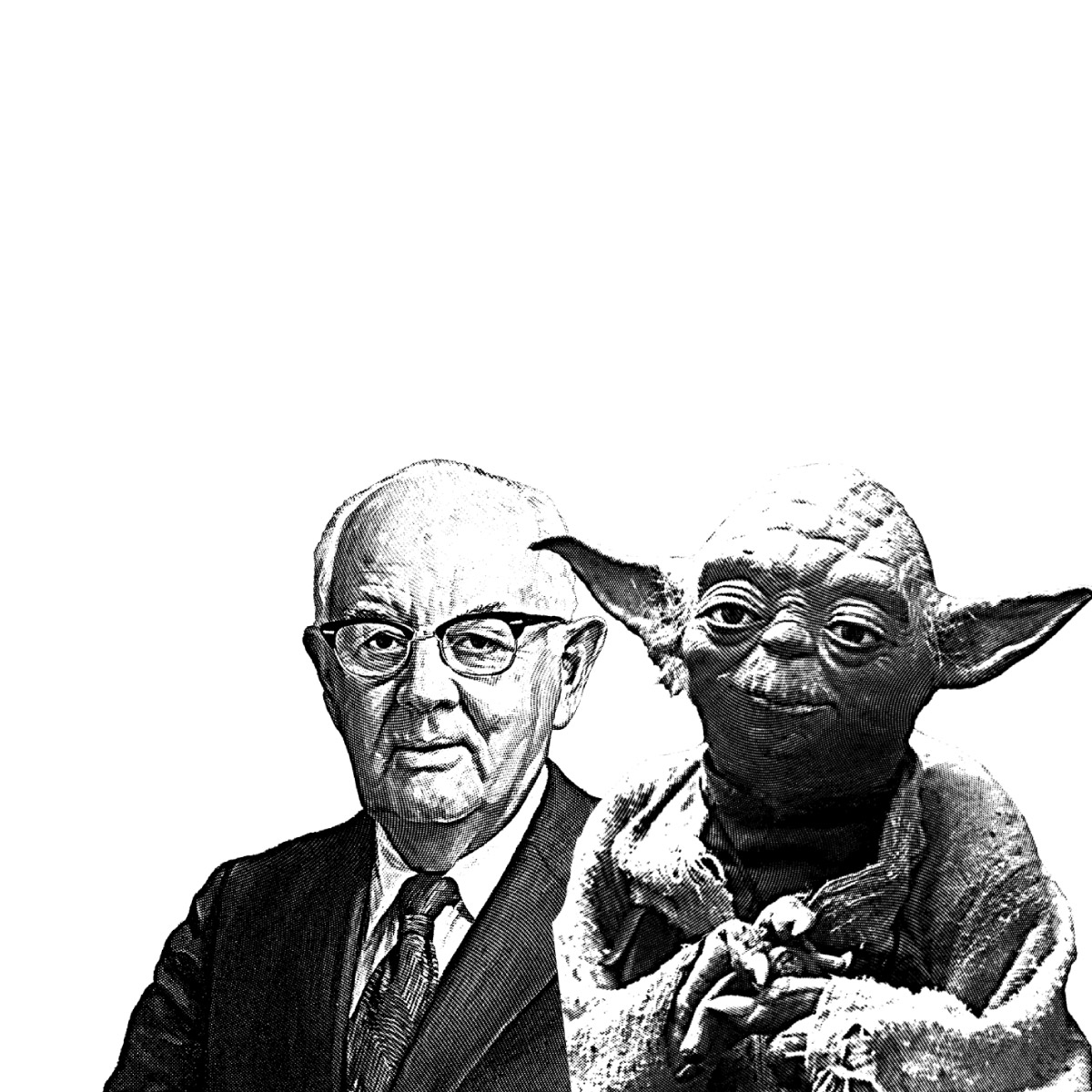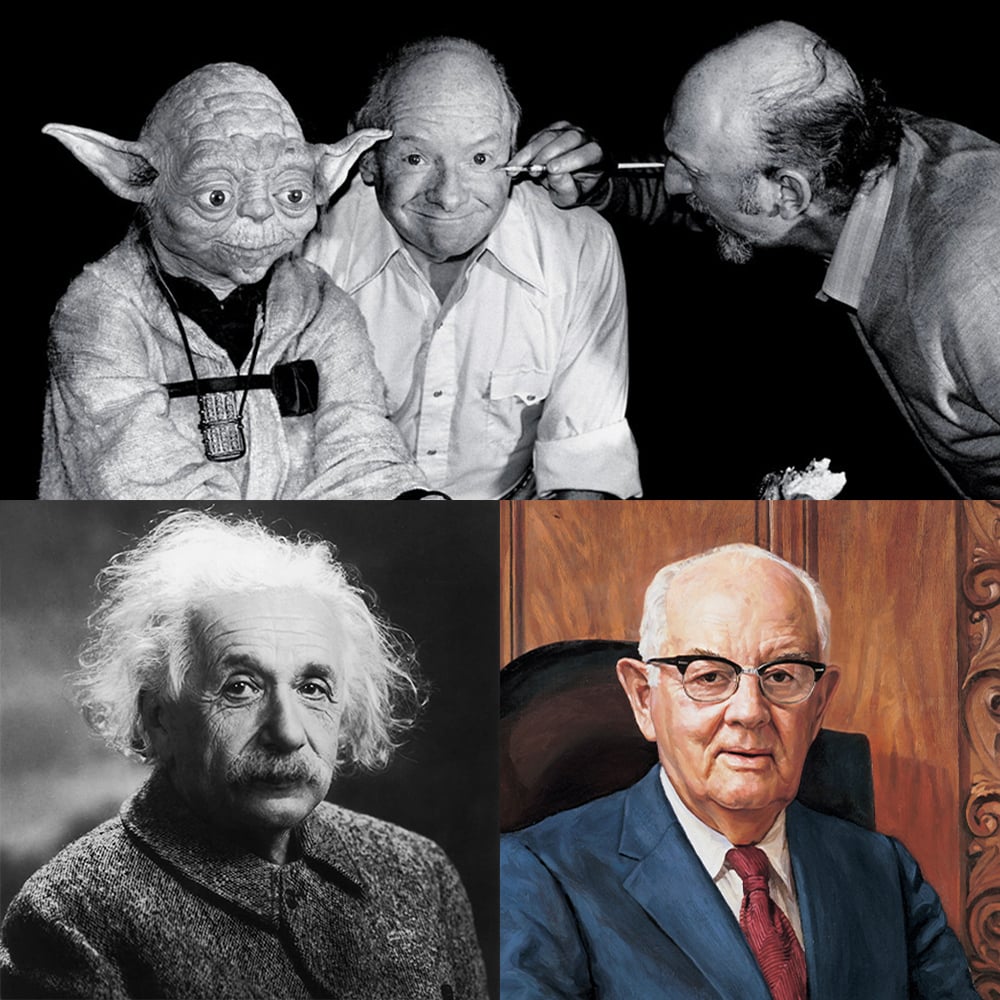Star Wars and Spencer W. Kimball

One of the more enduring "Mormon myths" is that the character design for the beloved Star Wars character, Yoda, was inspired by the Latter-day Saint prophet Spencer W. Kimball. This Q&A explores Yoda's origins and how Star Wars intersects with Church culture, organization, and teachings.

Is Yoda modeled on Spencer W. Kimball?
No, probably not. Many people involved with the production of Star Wars have talked about the creation and design of Yoda,[BIO][1] but there is no record of anyone citing Spencer W. Kimball[BIO] as inspiration. The designers[2] of Yoda have referenced influences such as Albert Einstein[BIO][3] and the sculptor of the original Yoda model, Stuart Freeborn.[BIO][4]

Where does this myth come from?
It's unclear. The earliest known published source for the Yoda-Kimball connection is from the November 1980 issue of the science fiction fanzine Telos where the author commented that a painting of "Prez Kimball" looked "very much like a pink and earless Yoda."[5] More recently, several publications have picked up on the myth.[6]
Why would people think that Spencer W. Kimball and Yoda are similar?
Some possible reasons include popularity in the early 1980s, short statures, wispy white hair, and similar sayings like "Do it" and "Do, or do not."[7]
Do Yoda and Star Wars teach the principles of the Gospel?
Sometimes (see the table below).
Table of Star Wars and Gospel similarities
Yoda/Star Wars Reference | Comparable Gospel Concept |
Yoda: "Luminous beings are we, not this crude matter"[8] | Doctrine and Covenants section 131 teaches that "there is no such thing as immaterial matter. All spirit is matter."[9] |
Yoda: “Size matters not. Look at me. Judge me by my size, do you?"[10] | Marvin J. Ashton of the Quorum of the Twelve Apostles taught, "When the Lord measures an individual, He does not take a tape measure around the person’s head to determine his mental capacity, nor his chest to determine his manliness, but He measures the heart as an indicator of the person’s capacity and potential to bless others."[11] |
Yoda: "Fear is the path to the dark side. Fear leads to anger. Anger leads to hate. Hate leads to suffering."[12] | Dieter F. Uchtdorf of the Quorum of the Twelve Apostles taught that "People who are fearful . . . often feel helpless and resentful, even angry. Over time these feelings lead to mistrust, defiance, even rebellion."[13] |
Yoda: “Truly wonderful the mind of a child is."[14] | Thomas S. Monson, President of the Church from 2008 – 2018, observed that "in our daily experiences with children, we discover they are most perceptive and often utter profound truths."[15] |
Light Side / Dark Side[16] | The rhetoric of war between "good and evil" is well-established in scripture and modern Church teachings. For example, Apostle Jeffrey R. Holland shared the following: What is equally obvious is that the great conflict between good and evil, right and wrong, the moral and the immoral—conflict which the world’s great faiths and devoted religious believers have historically tried to address—is being intensified in our time and is affecting an ever-wider segment of our culture. And let there be no doubt that the outcome of this conflict truly matters, not only in eternity but in everyday life as well.[17] |
The Force[18] | Latter-day Saint theology teaches of the Holy Ghost, an ever-present force for guidance, discernment, and strength. The Prophet Brigham Young shared a vision in which the late Joseph Smith stated, Tell the people. . . to keep the spirit of the Lord and it will lead them right. Be careful and not turn away the small still voice; it will teach them what to do and where to go; it will yield the fruits of the Kingdom. … Tell the brethren that if they will follow the spirit of the Lord, they will go right.[19] |
Force Ghosts[20] | Latter-day Saint doctrine contains teachings about the sentience and progress of the spirits of mankind after death. For example, President Brigham Young taught the following about the spirits of people after they die: Suppose, then, that a man is evil in his heart—wholly given up to wickedness, and in that condition dies, his spirit will enter into the spirit world intent upon evil. On the other hand, if we are striving with all the powers and faculties God has given us to improve upon our talents, to prepare ourselves to dwell in eternal life, and the grave receives our bodies while we are thus engaged, with what disposition will our spirits enter their next state? They will be still striving to do the things of God, only in a much greater degree—learning, increasing, growing in grace and in the knowledge of the truth.[21] |
Are other elements of Star Wars such as the Jedi Council inspired by the Church organization?
No, probably not. Various sources of inspiration for Star Wars lore have been cited including the novel Dune,[22] Kurosawa films,[23] and a Nazi aesthetic (used for the Empire),[24] but the Latter-day Saint Church organization and doctrine have never been cited as influences by those who worked on the films.
Wasn't Gary Kurtz, a Star Wars and The Empire Strikes Back producer, a Latter-day Saint?
Possibly. Claims that Gary Kurtz[BIO] was a Latter-day Saint[25] probably come from a 1999 George Lucas[BIO] biography stating, "Kurtz was raised as a Mormon, and refused to fight in Vietnam from religious conviction."[26] However, some sources say he was a Quaker.[27]
But wasn't there some 1970s sci-fi show that was influenced by Latter-day Saint ideas?
Yes. Glen Larson,[BIO] the creator of the 1978 Battlestar Galactica television series, was a practicing Latter-day Saint.[28] The fictional series included references to Kolob,[29] a "Quorum of Twelve,"[30] and marriages that were "sealed" in a union "not only for now, but for all the eternities."[31]
Related Question
Is Kolob a central concept in Latter-day Saint theology?
Read more in Kolob
Do Latter-day Saints like Star Wars?
It seems like it. During the week leading to the release of 2015's Star Wars: The Force Awakens, Utahns were more likely than residents of any other state to make Star Wars-related Google searches,[32] and two Utah local theaters opened the film in the top ten nationally.[33] The Tabernacle Choir and Orchestra at Temple Square has also performed music from the Star Wars films.[34]
Related Question
Is it against the Church rules to watch R-rated movies?
Read more in R-Rated Movies
Have General Authorities ever referenced Star Wars in talks?
Yes, but only recently. Star Wars has been referenced twice in General Conference in 2016 and 2017,[35] and in two BYU devotionals in 2017 and 2022.[36]
- Bjork
“I think he is a combination of famous religious and intellectual leaders of the day, along with the familiar of his own face. They didn't have Google back then but they would have newspapers and magazines. General Conference pictures would be available.” - Katie T
“This is a fun theory but One of the designers of Yoda modeled him after himself and if you see pictures he looks more like Yoda than Kimball.”



 about this topic
about this topic